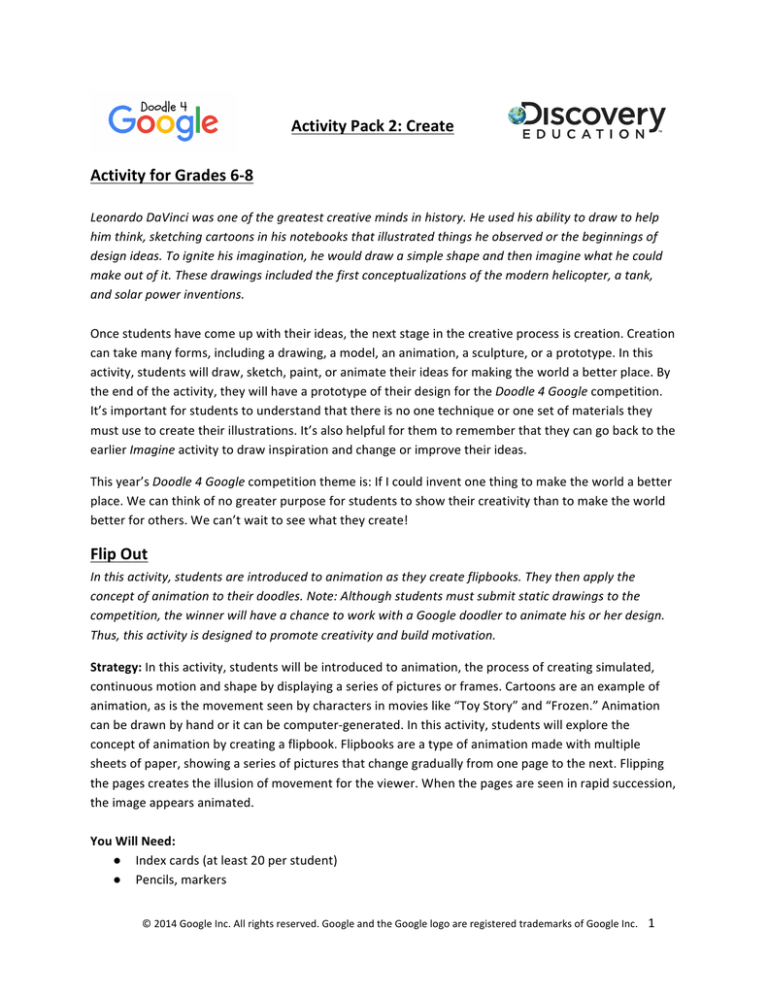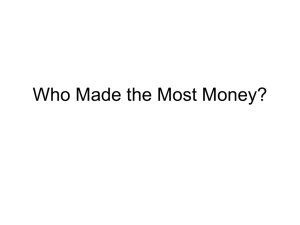
Activity Pack 2: Create Activity for Grades 6-­‐8 Leonardo DaVinci was one of the greatest creative minds in history. He used his ability to draw to help him think, sketching cartoons in his notebooks that illustrated things he observed or the beginnings of design ideas. To ignite his imagination, he would draw a simple shape and then imagine what he could make out of it. These drawings included the first conceptualizations of the modern helicopter, a tank, and solar power inventions. Once students have come up with their ideas, the next stage in the creative process is creation. Creation can take many forms, including a drawing, a model, an animation, a sculpture, or a prototype. In this activity, students will draw, sketch, paint, or animate their ideas for making the world a better place. By the end of the activity, they will have a prototype of their design for the Doodle 4 Google competition. It’s important for students to understand that there is no one technique or one set of materials they must use to create their illustrations. It’s also helpful for them to remember that they can go back to the earlier Imagine activity to draw inspiration and change or improve their ideas. This year’s Doodle 4 Google competition theme is: If I could invent one thing to make the world a better place. We can think of no greater purpose for students to show their creativity than to make the world better for others. We can’t wait to see what they create! Flip Out In this activity, students are introduced to animation as they create flipbooks. They then apply the concept of animation to their doodles. Note: Although students must submit static drawings to the competition, the winner will have a chance to work with a Google doodler to animate his or her design. Thus, this activity is designed to promote creativity and build motivation. Strategy: In this activity, students will be introduced to animation, the process of creating simulated, continuous motion and shape by displaying a series of pictures or frames. Cartoons are an example of animation, as is the movement seen by characters in movies like “Toy Story” and “Frozen.” Animation can be drawn by hand or it can be computer-­‐generated. In this activity, students will explore the concept of animation by creating a flipbook. Flipbooks are a type of animation made with multiple sheets of paper, showing a series of pictures that change gradually from one page to the next. Flipping the pages creates the illusion of movement for the viewer. When the pages are seen in rapid succession, the image appears animated. You Will Need: ● Index cards (at least 20 per student) ● Pencils, markers © 2014 Google Inc. All rights reserved. Google and the Google logo are registered trademarks of Google Inc. 1 ●
●
●
Whiteboards (optional) Computers or tablets Access to the Internet 1. Invite students to go online and look at the following Google doodles: ● New Year’s Day 2014: http://www.google.com/doodles/new-­‐years-­‐day-­‐2014 ● Claude Debussy’s 151st birthday: http://www.google.com/doodles/claude-­‐debussys-­‐151st-­‐
birthday ● Martha Graham’s 117th birthday: http://www.google.com/doodles/martha-­‐grahams-­‐117th-­‐
birthday ● Art Clokey’s 90th birthday: http://www.google.com/doodles/art-­‐clokeys-­‐90th-­‐birthday 2. Ask them to describe what they see in each doodle and to identify what the doodles have in common. Explain that, unlike some Google doodles, these have movement or animation. 3. Ask students to share what they know about how animation is created. Explain that animation is created through a series of freeze frames. Each freeze frame shows a very slight sequence of motion. When put together quickly, the frames give the appearance of movement. 4. You can share with students that many animators get their inspiration from real objects. In fact, for the 1942 movie Bambi, two live fawns were shipped to Disney’s California studio so animators could watch their movements up close in order to draw them. Today’s high-­‐quality animated films are produced at a frame rate of 24 frames per second. For a 90 minute film, that's nearly 130,000 frames of animation. 5. While most animation done today is computer generated, explain to students that they will be introduced to the art form by creating a flipbook that animates one object. 6. Distribute 20-­‐30 index cards to each student. Instruct students to number each card from 1-­‐20. 7. Ask students to identify an object they would like to illustrate and animate. This object should be something that is easy for them to draw since they will be drawing it many times with slight changes in each drawing. 8. Invite students to draw their object on card #1. Then, direct them to draw how they would like the object to look at the end of the animation on card #20. Ask them to find card #10 and place it on top of the already drawn cards as in a stack. Hold the three cards up to a window and draw the object in what would be the state halfway between what it looks like on card 1 and what it looks like on card 20. These three cards are then considered the key frame cards. Remaining cards will show the object as it progresses from first to last. 9. With each successive drawing, invite students to find the card that is halfway between the ones © 2014 Google Inc. All rights reserved. Google and the Google logo are registered trademarks of Google Inc. 2 they have already drawn and to draw the object as it would be halfway between those two cards. Each card should show minor movement. Continue until all cards have been illustrated. 10. Finally, staple the cards together in order like a book, and quickly flip the book to show the animation. 11. Discuss the exercise. How easy or difficult was it to show the movement? How do students think this exercise could be simulated on a computer? 12. Ask students to consider how animation could play a role as they think about their doodle for the Doodle 4 Google competition. Explain that, while they are not allowed to include animation in their entry, the winning student will work with the real Google doodlers to actually animate his or her doodle! If you have not already introduced the rules for the competition or shown students examples of previous doodles, now is a good time to do so. Information and previous entries can be viewed at www.google.com/doodle4google. Make sure students understand that their artwork must incorporate the Google logo. Sample Google doodles are available at http://www.google.com/doodles/finder/2014/All%20doodles. 13. Invite students to create a draft of their competition doodle that they will tweak and finalize in the Share and Collaborate activity pack. Their prototype doodle must show how they would make the world better, include the word “Google,” and follow the rules of the competition. Invite them to select one element of their doodle that they would like to animate if they were the competition winner! Take It Digital! If students want to explore computer-­‐generated animation, encourage them to visit: ● Animasher: This simple drag-­‐and-­‐drop, Web-­‐based animator offers a library of images, voice and video clips and sound effects for creating quick projects. Use existing clip art and sound, or upload your own elements to create projects. ● Animation Desk: app for creating short, animated videos. Allows you to create drawings using just your finger on your table. In the free version of the app you can create up to 50 scenes in each of your projects. In each scene you can include as little or as much as you want to draw on the canvas. There are a few different brush and pencil effects that you can use in your drawings. The opacity of the colors you choose can be altered too. When you have completed drawing all of your scenes hit the play button to watch your animation unfold. If you’re happy with your animation you can export it to YouTube. ● ABCYA! Animate: Abcya.com is a teacher-­‐created website which provides fun and educational games and apps for kids to use under the guidance of their parents and teachers. ABCYA has an animation tool that allows users to create a series of drawings and animate them into a flip book. The new version features a colorful and intuitive interface, 100 frames, grouping, arranging and over 100 images. ● Kerpoof: Owned and operated by Disney, this Web-­‐based studio designed for young people is © 2014 Google Inc. All rights reserved. Google and the Google logo are registered trademarks of Google Inc. 3 all about making art and animated movies. Kerpoof offers many different movie-­‐making programs and activities organized by grade level and cross-­‐referenced with state and national educational standards. Winner of a 2010 Parents’ Choice Gold Award, the site is mostly free, with premium membership options. © 2014 Google Inc. All rights reserved. Google and the Google logo are registered trademarks of Google Inc. 4




